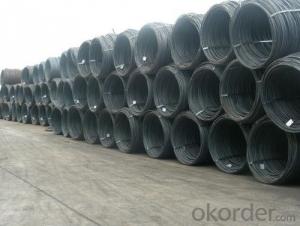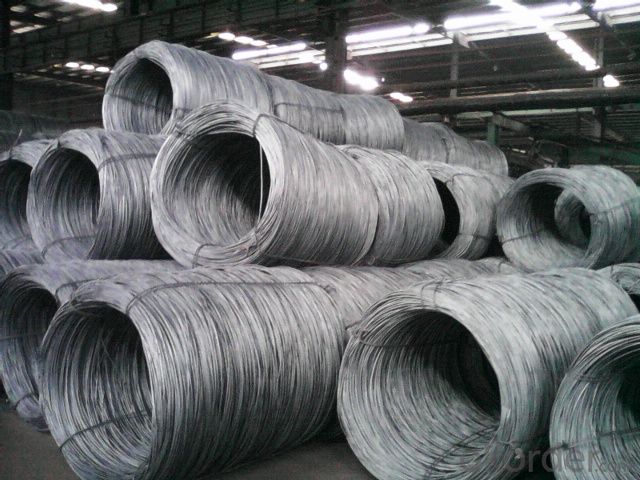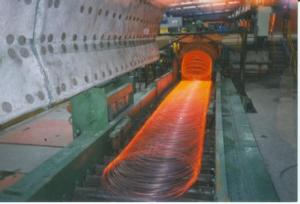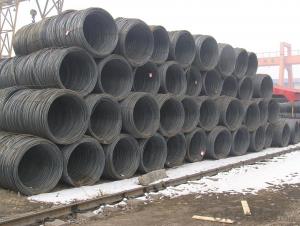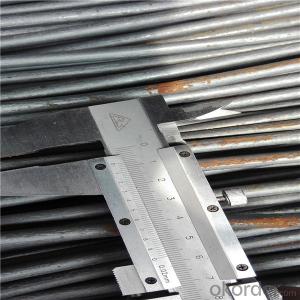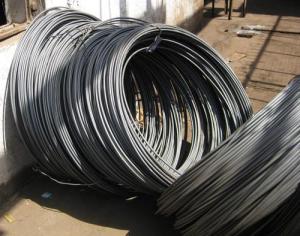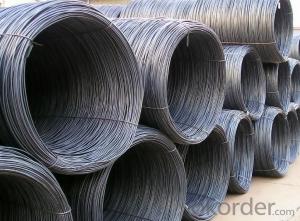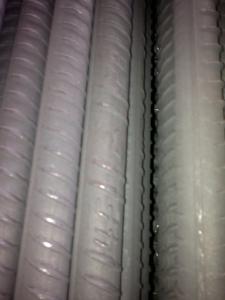Mild Steel Prime Hot Rolled Wire Rod in Coil
- Loading Port:
- China main port
- Payment Terms:
- TT OR LC
- Min Order Qty:
- 100 m.t.
- Supply Capability:
- 10000 m.t./month
OKorder Service Pledge
OKorder Financial Service
You Might Also Like
Specification
Product Description:
OKorder is offering Mild Steel Prime Hot Rolled Wire Rod in Coil at great prices with worldwide shipping. Our supplier is a world-class manufacturer of steel, with our products utilized the world over. OKorder annually supplies products to African, South American and Asian markets. We provide quotations within 24 hours of receiving an inquiry and guarantee competitive prices.
Product Applications:
Mild Steel Prime Hot Rolled Wire Rod in Coil are ideal for structural applications and are widely used in the construction of buildings and bridges, and the manufacturing, petrochemical, and transportation industries.
Product Advantages:
OKorder's Mild Steel Prime Hot Rolled Wire Rod in Coil are durable, strong, and wide variety of sizes.
Main Product Features:
· Premium quality
· Prompt delivery & seaworthy packing (30 days after receiving deposit)
· Can be recycled and reused
· Mill test certification
· Professional Service
· Competitive pricing
Product Specifications:
Manufacture: Hot rolled
Grade: Q195 – 235, SAE1008, SAE1006
Certificates: ISO, SGS, BV, CIQ
Packaging: Export packing, nude packing, in coil
Size: 5.5mm, 6.5mm, 7mm, 8mm, 9mm, 10mm, 12mm
Grade | Chemical Composition(%) | |||||
C | Mn | Si | S | P | Cr | |
SAE1006Cr | 0.03~O.07 | ≤0.32 | ≤0.30 | ≤0.045 | ≤0.040 | >0.3 |
Mechanical properties | ||||||
Yield strength(N/mm2) | Tensile strength(N/mm2) | Elongation(%) | ||||
250-280 | 350-380 | ≥32 | ||||
Grade | Chemical Composition(%) | |||||
C | Mn | Si | S | P | Cr | |
SAE1008Cr | 0.10max | 0.3~O.50 | 0.15max | 0.050max | 0.040 max | 0.3 min |
Mechanical properties | ||||||
Yield strength(N/mm2) | Tensile strength(N/mm2) | Elongation(%) | ||||
≥195 | 315-430 | ≥30 | ||||
Grade | Chemical Composition(%) | |||||
C | Mn | Si | S | P | Cr | |
Q195Cr | 0.06~O.12 | 0.25~O.50 | ≤0.30 | ≤0.050 | ≤0.045 | >0.3 |
Mechanical properties | ||||||
Yield strength(N/mm2) | Tensile strength(N/mm2) | Elongation(%) | ||||
≥195 | 315-430 | ≥33 | ||||
Grade | Chemical Composition(%) | |||||
C | Mn | Si | S | P | Cr | |
Q235Cr | 0.12~O.2 | 0.3~O.701 | ≤0.30 | ≤0.045 | ≤0.045 | >0.3 |
Mechanical properties | ||||||
Yield strength(N/mm2) | Tensile strength(N/mm2) | Elongation(%) | ||||
235 | 375-500 | ≥26 | ||||
FAQ:
Q1: Why buy Materials & Equipment from OKorder.com?
A1: All products offered byOKorder.com are carefully selected from China's most reliable manufacturing enterprises. Through its ISO certifications, OKorder.com adheres to the highest standards and a commitment to supply chain safety and customer satisfaction.
Q2: How do we guarantee the quality of our products?
A2: We have established an advanced quality management system which conducts strict quality tests at every step, from raw materials to the final product. At the same time, we provide extensive follow-up service assurances as required.
Q3: How soon can we receive the product after purchase?
A3: Within three days of placing an order, we will arrange production. The normal sizes with the normal grade can be produced within one month. The specific shipping date is dependent upon international and government factors, the delivery to international main port about 45-60days.
Images:
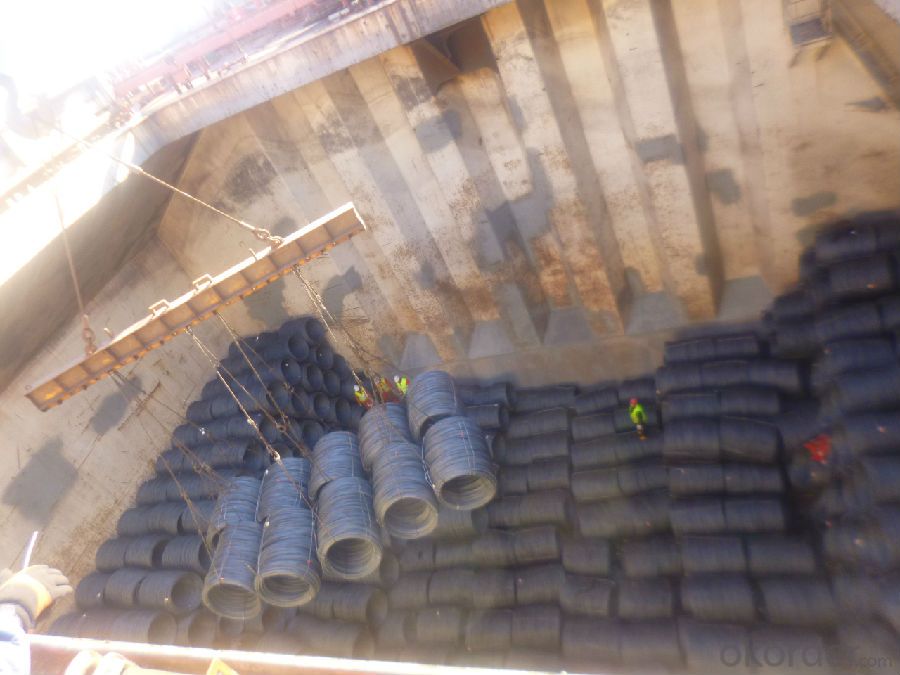
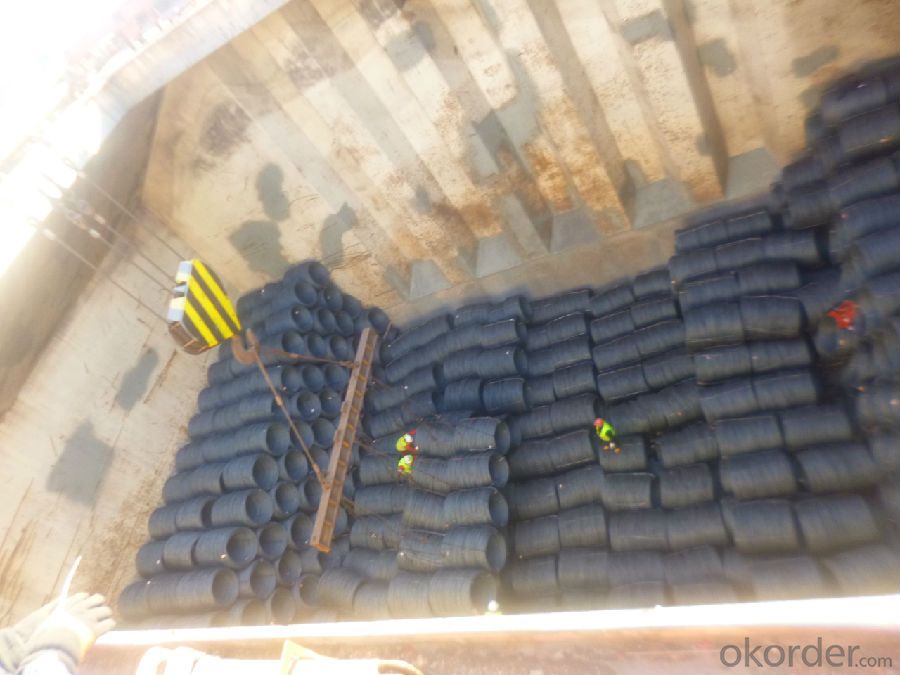
- Q: How is steel wire rod used in the manufacturing of wire forms for playground equipment?
- In the production of wire forms for playground equipment, steel wire rod plays a vital role. Made from high-quality steel, the wire rod comes in different diameters to meet various needs. To manufacture wire forms for playground equipment, the steel wire rod undergoes several manufacturing steps. Initially, it is fed into a machine that cleans and eliminates any impurities from its surface, ensuring its cleanliness for further processing. Subsequently, the wire rod passes through a drawing machine that reduces its diameter to the desired size. This process involves pulling the wire rod through a series of dies, gradually decreasing its diameter while increasing its length. This drawing process not only shapes the wire but also enhances its strength and durability. Once the wire reaches the desired diameter, it undergoes annealing to relieve internal stress and improve its malleability. This facilitates the bending and shaping of the wire into the required forms for playground equipment. Following the annealing process, the wire is ready for forming. During this stage, specialized machines and tools are used to bend, twist, and shape the wire into various components such as hooks, loops, spirals, and curves, according to the specific design requirements of the playground equipment. Subsequently, the formed wire undergoes a heat treatment process called quenching and tempering, further enhancing its strength and durability to withstand the demands of playground use. Finally, the wire forms are coated with a protective finish, such as galvanization or powder coating, to prevent corrosion and extend their lifespan. The choice of coating material depends on the specific requirements of the playground equipment. In conclusion, steel wire rod is an essential component in the manufacturing process of wire forms for playground equipment. Its strength, durability, and malleability make it the ideal material for creating safe and reliable wire forms that can withstand the rigors of playground use.
- Q: How is steel wire rod used in the manufacturing of wire ropes for elevators?
- Steel wire rod is used as the raw material in the manufacturing process of wire ropes for elevators. It is first drawn into thin wires and then twisted together to form strands. These strands are then further twisted and combined to create a strong and durable wire rope, which is used to support the weight and movement of elevator systems. The high tensile strength and flexibility of steel wire rod make it an ideal choice for ensuring the safety and reliability of elevator operations.
- Q: How is steel wire rod used in the manufacturing of wire forms for aerospace applications?
- Steel wire rod is an essential component in the manufacturing of wire forms for aerospace applications. It is primarily used as the raw material for wire drawing, where it undergoes a series of processes to transform it into wire forms with specific dimensions and characteristics. The first step in the manufacturing process is to select high-quality steel wire rod that meets stringent aerospace industry standards. This ensures that the wire forms possess the necessary strength, durability, and resistance to corrosion required for aerospace applications. Once the appropriate steel wire rod is obtained, it is fed through a series of dies in a wire drawing machine. This process involves pulling the wire rod through progressively smaller dies to reduce its diameter and increase its length. The wire drawing process not only shapes the wire but also refines its microstructure, resulting in improved mechanical properties. After wire drawing, the steel wire is further processed depending on the specific requirements of the wire forms. It can undergo additional treatments such as heat treatment, surface coating, or plating to enhance its performance and meet the stringent standards of the aerospace industry. The wire forms manufactured from steel wire rod find a wide range of applications in the aerospace sector. They are used in the production of aircraft components like springs, fasteners, connectors, wire harnesses, and control cables. These wire forms play a crucial role in ensuring the structural integrity, functionality, and safety of various aerospace systems. The use of steel wire rod in the manufacturing of wire forms for aerospace applications offers numerous advantages. Steel is known for its high strength-to-weight ratio, excellent fatigue resistance, and good electrical conductivity. These properties make steel wire forms ideal for withstanding the demanding conditions experienced in the aerospace industry. In conclusion, steel wire rod is a crucial raw material in the manufacturing of wire forms for aerospace applications. Its transformation through processes like wire drawing and additional treatments results in wire forms with the necessary properties to meet the stringent requirements of the aerospace industry. These wire forms contribute significantly to the structural integrity and functionality of various aerospace systems.
- Q: What are the common cutting methods for steel wire rod?
- The common cutting methods for steel wire rod include shearing, sawing, and abrasive cutting.
- Q: What are the current trends in the steel wire rod market?
- Some current trends in the steel wire rod market include increasing demand for high-quality steel wire rods in the construction and automotive industries, growing preference for stainless steel wire rods due to their corrosion resistance properties, and rising focus on sustainable and eco-friendly production processes in the steel industry. Additionally, advancements in technology and automation are also influencing the market, leading to improved efficiency and productivity in steel wire rod manufacturing.
- Q: How is steel wire rod used in the production of wire for mesh filters?
- The production of wire for mesh filters relies heavily on steel wire rod, which is an indispensable component. To ensure the quality and performance of the wire rod, it undergoes a series of steps. One common method is hot rolling, which involves heating the wire rod to high temperatures and passing it through rollers to shape it uniformly. After hot rolling, the wire rod is cooled and further processed to eliminate any scale or imperfections on its surface. This process guarantees a smooth and defect-free wire, essential for maintaining the mesh filter's quality. The wire rod is then drawn through dies to reduce its diameter and increase its length. This wire drawing process not only enhances the wire's strength but also improves its tensile properties. The drawn wire can be woven or welded to create the mesh filter. Weaving involves interlacing the wire in a crisscross pattern, suitable for finer mesh filters requiring precision. Conversely, welding involves joining individual wires using heat or pressure, resulting in a solid mesh structure. This method is commonly used for larger or more durable mesh filters. The choice of steel wire rod is critical as it determines the final product's quality and performance. Manufacturers carefully select the composition and tensile strength of the wire rod to meet the specific requirements of the mesh filter. It is crucial to use high-quality wire rod that offers excellent corrosion resistance, durability, and dimensional stability, ensuring the mesh filter's longevity and effectiveness. In conclusion, steel wire rod plays a vital role in the production of wire for mesh filters. Through processes such as hot rolling, wire drawing, and surface treatment, the wire rod achieves the desired properties. Whether woven or welded, the mesh structure determines the filter's precision, strength, and durability. By utilizing high-quality steel wire rod, manufacturers can produce superior mesh filters that effectively fulfill the filtration needs of various industries.
- Q: What are the different ductility testing methods for steel wire rod?
- Steel wire rods can be assessed for ductility using various testing methods. These methods measure the material's ability to deform under tensile stress without breaking. Some commonly used tests for steel wire rods include: 1. Tensile Test: This is the most frequently employed method for evaluating ductility. It involves subjecting a wire rod specimen to increasing tensile force until it fractures. The elongation and reduction in area of the specimen are measured to determine its ductility. 2. Bend Test: This test assesses the material's ability to withstand bending without cracking or fracturing. A wire rod specimen is bent to a predetermined angle, and any visible defects or changes are documented to evaluate its ductility. 3. Cupping Test: This test determines the deep-drawing quality of steel wire rods. A specimen is deformed into a cup shape using a die and punch. The material's ability to undergo deformation without cracking or tearing indicates its ductility. 4. Charpy Impact Test: While primarily used for measuring toughness, this test also provides insights into the ductility of steel wire rods. A notched specimen is subjected to a high-velocity impact, and the energy absorbed during fracture is measured. Higher energy absorption suggests good ductility. 5. Fatigue Test: This test indirectly assesses the ductility of steel wire rods by evaluating their fatigue resistance. The specimen is subjected to repeated cyclic loading until failure, and the number of cycles required is recorded. Materials with high ductility are expected to have better fatigue resistance. These testing methods offer valuable information about the ductility properties of steel wire rods, aiding engineers and manufacturers in selecting the most suitable material for specific applications.
- Q: What are the different types of steel wire rod finishes for improved chemical resistance?
- There are several types of steel wire rod finishes that can be used to enhance chemical resistance. Some common finishes include galvanized, stainless steel, and epoxy-coated. Galvanized finishes involve coating the steel wire rod with a layer of zinc, which provides protection against corrosion and chemical reactions. Stainless steel finishes are highly resistant to corrosion and are often used in environments with acidic or alkaline substances. Epoxy-coated finishes involve applying a layer of epoxy resin to the steel wire rod, providing a barrier against chemicals and preventing corrosion. Overall, these finishes help improve the chemical resistance of steel wire rods in various applications.
- Q: What are the different types of steel wire rod rolling processes?
- There are several different types of steel wire rod rolling processes, including hot rolling, cold rolling, and warm rolling. Each process has its own advantages and is used for specific applications. Hot rolling involves heating the steel rod and then passing it through a series of rollers to reduce its diameter and increase its length. Cold rolling, on the other hand, is performed at room temperature and results in a smoother finish and increased strength. Warm rolling is a combination of hot and cold rolling, where the steel rod is heated to a lower temperature than in hot rolling but higher than in cold rolling. This process offers a balance between strength and surface quality.
- Q: What are the heat treatment processes used for steel wire rod?
- The heat treatment processes commonly used for steel wire rod include annealing, quenching and tempering, and stress relieving.
Send your message to us
Mild Steel Prime Hot Rolled Wire Rod in Coil
- Loading Port:
- China main port
- Payment Terms:
- TT OR LC
- Min Order Qty:
- 100 m.t.
- Supply Capability:
- 10000 m.t./month
OKorder Service Pledge
OKorder Financial Service
Similar products
Hot products
Hot Searches
Related keywords
